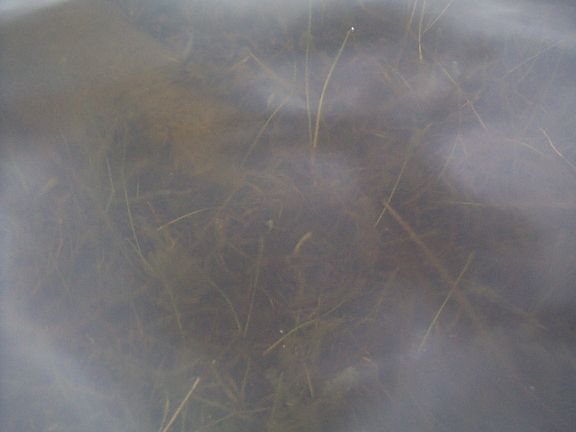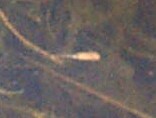See Field Guide to The Santa Rosa Plateau: Vernal Pools: Introduction for an introduction to this page.
The following are beautiful pictures taken by Ted St. John of the fairy shrimp in the Main Pool on 10 February 2008 with an Olympus SP-550. Ted says This is a digital camera that has the equivalent of a 1000mm telephoto and a magnifying glass in the same lens, and can take pictures that come out brighter than the light that your eye can see.
The following picture shows a single male fairy shrimp, along with its shadow cast on the below-water portion of the boardwalk support, accompanied by a much smaller red copepod, with two long antennae, at upper left. This fairy shrimp is a male due to its large claspers, used in mating, attached to its head.

The following picture shows three fairy shrimp and their shadows. The one at upper right probably is a female with its two lateral patches holding eggs.

Another picture of three shrimp, including one male:

The following picture shows a female with her single brood pouch full of eggs:

Even better, Ted has made a wonderful movie that allows you to see the shrimp in action, showing off all those legs moving while swimming upside down.
However, unless you have a top end camera like Ted has, the following are more typical results. They also correspond more to what is seen by the human eye, and shows the difficulty of seeing the shrimp. You'll never see the fairy shrimp as clearly by eye as they appear in Ted's pictures and movies!
I had never even entertained the possibility that one could take pictures of the fairy shrimp with an ordinary camera, since they are transparent and hence nearly invisible. Given that many people cannot find the shrimp by themselves, and even have difficulty seeing them when someone is pointing out the moving fairy shrimp, I would have said it was probably impossible.
Indeed, much of the time it clearly is impossible to photograph the shrimp with a normal camera. The following picture is an unenhanced picture taken with my Kodak DC200 digital camera that contains at least 5-6 normal fairy shrimp that are 1/2-3/4" long:

Can you see any fairy shrimp in this picture? The waves on the surface of the water reflect the cloudy sky and produce the milky gray opacity around the edges of the picture. The Pool is about 15" deep here, and one is seeing all the way to the bottom of the Pool. The visible features consist nearly entirely of plant stems that grew when the Pool was dry, and were subsequently drowned by the Pool. Algae are growing on a number of the stems, further confusing the interpretation of the picture.
Below is an enhanced version of that picture, with one definite fairy shrimp labeled, one definite "algae on a grass stem" labeled, and three possible fairy shrimps circled:

From observation by eye, I knew that they were at least 5-6 fairy shrimp in this picture. However, I can clearly identify only one in the above picture, with three other possible fairy shrimps, all within the ovals drawn on the picture. Algae on a plant stem, one example given within the marked rectangle, is easily confused with a fairy shrimp. The fairy shrimp clearly do not make good photo subjects with a normal camera.
But on 11 March 2001, some visitors to the Pool found a mutant fairy shrimp that was colored! It stood out so vividly to the eye that I attempted to take its picture, as well as the other pictures on this page. I went ahead and photographed some of the other shrimp, just to see what happened. The results are below.
Mutant Fairy Shrimp Pictures
This shrimp had a vivid clear color, one I did not note at the time since I was so shocked at the time by its appearance. The color may have been a whitish-red, almost reminiscent of the shrimp we eat:
 | 
|
Isn't it amazing how clearly the shrimp stands out?
The shrimp is swimming from left to right. The right half of the shrimp consists of its fatter main body, with its legs up, swimming in its normal upside-down fashion. The left half is the thin tail. The shrimp is about 1/2 - 3/4" long.
Normal Fairy Shrimp Pictures
Normal fairy shrimp usually are indeed hard to photograph, as seen in the first picture above. However, when the white egg cases are present, the additional contrast makes them much more photogenic:
 | 
|
 | 
|
There are two sets of pictures above. On the left is a portion of the original camera pictures. On the right is an enhanced view of the fairy shrimp contained in the picture on the left.
It is difficult to be 100% sure what the top set of picture shows, but I believe it is a normal fairy shrimp without an egg case. The picture probably shows the top half of the fairy shrimp, with the tail virtually invisible.
The bottom set of pictures show the head of the shrimp at upper left, a fuzzy gray-whitish portion that is the legs and main body of the shrimp, and the bright white egg sac followed by the rest of its tail.